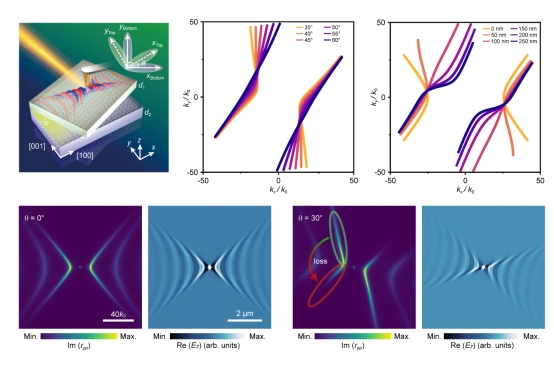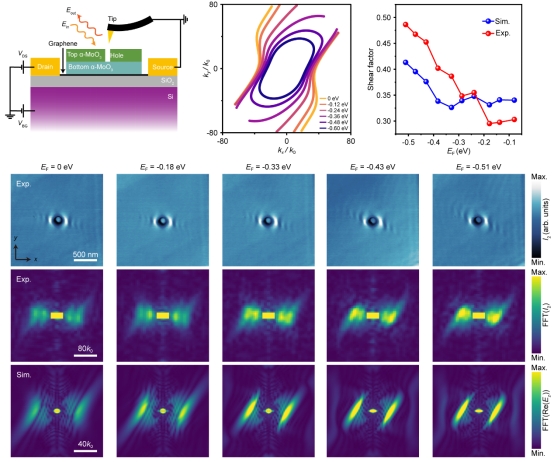In the field of micro-nano photonics, precise control of nanoscale optical field distribution remains a key technological challenge. Traditional optical devices are limited by the diffraction limit of light, making it difficult to achieve efficient optical field manipulation below the 100-nanometer scale. As quasiparticles formed by the coupling of light and matter, polaritons can compress optical fields to the nanoscale, offering a new pathway to overcome this limit. Recently, shear polaritons in natural three-dimensional crystals have been shown to enable asymmetric light propagation, further enhancing the directional control of nanoscale light. However, the regulation of such polaritons is constrained by the intrinsic properties of bulk materials, making dynamic modulation challenging.
To address this issue, Professor Jiang Tao from the teams of Professors Zhanshan Wang and Xinbin Cheng at the School of Physics Science and Engineering, Tongji University, in collaboration with Professor Andrea Alù from the City University of New York and Professor Xiang Ni from Central South University, proposed a strategy for controlling shear polaritons based on two-dimensional van der Waals materials. The research team leveraged the natural hyperbolic properties of α-phase molybdenum trioxide (α-MoO3) and constructed heterostructures with tunable interlayer twist angles to achieve multidimensional control of hyperbolic shear polaritons in a two-dimensional system. Experiments confirmed that by adjusting the thickness and twist angle of bilayer α-MoO3, the symmetry of the system can be significantly altered, thereby precisely controlling the propagation direction and modal distribution of nanoscale polaritons. Furthermore, coupling with a graphene field-effect transistor enabled in situ dynamic modulation of hyperbolic shear polaritons, providing new insights for the development of micro-nano optoelectronic devices. On March 26, 2025, the related findings were published online in Nature Communications under the title "Engineering shear polaritons in 2D twisted heterostructures."

Figure 1. Schematic of shear polaritons in twisted α-MoO3
This study induces hyperbolic shear polaritons in a two-dimensional system by constructing a twisted bilayer α-MoO3 structure. Further tuning of the interlayer twist angle and thickness effectively controls the propagation direction, energy dissipation, and local field intensity of the hyperbolic shear polaritons. Combining infrared scattering-type scanning near-field optical microscopy (s-SNOM) characterization with full-wave electromagnetic simulations, the study systematically elucidates the shear effect and loss modulation mechanisms of hyperbolic shear polaritons. Specifically, adjusting the twist angle enhances the asymmetric propagation characteristics of the polaritons, enabling efficient transmission of optical signals along specific directions while optimizing the local field distribution. Varying the thickness further enriches the propagation characteristics. Moreover, by introducing graphene and tuning its Fermi level, real-time dynamic modulation in response to an external electric field is successfully achieved.

Figure 2. Electrically tunable shear polaritons in twisted α-MoO3
Notably, this study not only overcomes the inherent limitations of shear polariton control in three-dimensional low-symmetry materials but also expands the tunability of shear polaritons through a two-dimensional material system, demonstrating their potential applications in dynamically tunable nano-optoelectronic devices.
Tongji University is the first affiliation of the paper. Professors Xinbin Cheng and Tao Jiang from Tongji University, along with Professor Andrea Alù from the City University of New York, are the corresponding authors. The first authors include Lei Zhou, a PhD student at Tongji University; Zerui Wang, a master's student at Tongji University; and Professor Xiang Ni from Central South University. Other key contributors to the paper include Professors Zhanshan Wang and Di Huang from Tongji University. This work was supported by the National Natural Science Foundation of China, the National Key R&D Program of China, and the Science and Technology Commission of Shanghai Municipality.
Paper link: https://www.nature.com/articles/s41467-025-58197-4
